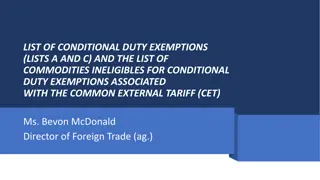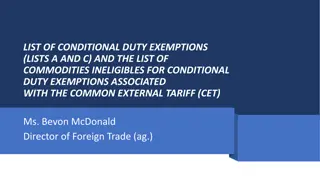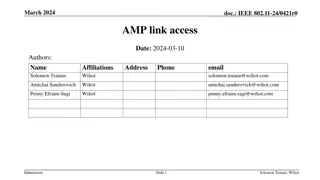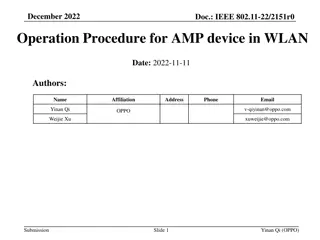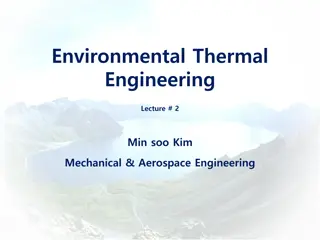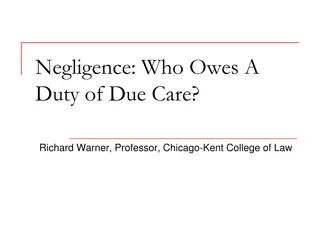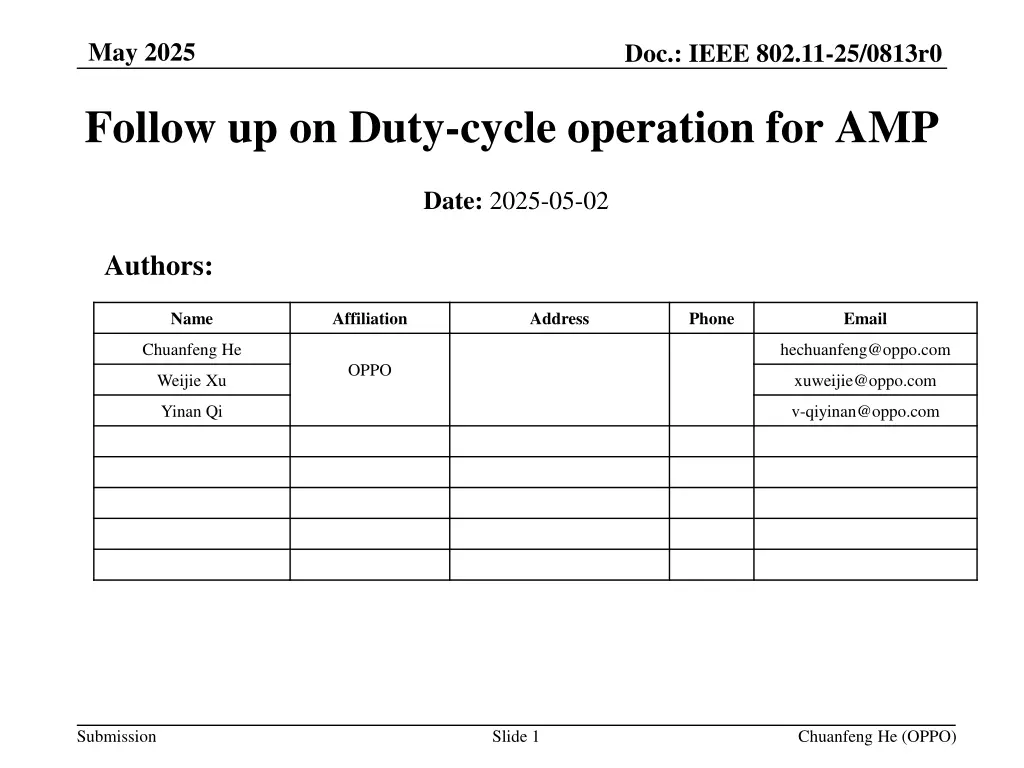
IEEE 802.11-25 Dutycycle Operation for AMP Communication
Explore duty-cycle operation for AMP communication in IEEE 802.11-25, focusing on power-saving techniques, use cases, configuration at AP and STA sides, and operational strategies. Learn about duty-cycle parameters, service periods, and reducing power consumption through efficient monitoring and transmission scheduling.
Download Presentation

Please find below an Image/Link to download the presentation.
The content on the website is provided AS IS for your information and personal use only. It may not be sold, licensed, or shared on other websites without obtaining consent from the author. If you encounter any issues during the download, it is possible that the publisher has removed the file from their server.
You are allowed to download the files provided on this website for personal or commercial use, subject to the condition that they are used lawfully. All files are the property of their respective owners.
The content on the website is provided AS IS for your information and personal use only. It may not be sold, licensed, or shared on other websites without obtaining consent from the author.
E N D
Presentation Transcript
May 2025 Doc.: IEEE 802.11-25/0813r0 Follow up on Duty-cycle operation for AMP Date: 2025-05-02 Authors: Name Affiliation Address Phone Email Chuanfeng He hechuanfeng@oppo.com OPPO Weijie Xu xuweijie@oppo.com Yinan Qi v-qiyinan@oppo.com Submission Slide 1 Chuanfeng He (OPPO)
May 2025 Doc.: IEEE 802.11-25/0813r0 Background For AMP communication, power storage is necessary for AMP STA to supply the operation power when simultaneously harvested power only is not enough to cover the consumed power[1]. Power saving from duty cycle It is challenging for AMP STA to perform consistent monitoring for potential AMP trigger for uplink transmission due to limited power storage. Duty-cycle operation can reduce the time duration of AMP STAs Rx, which are the main contributors of power consumption during awake time. The motions related to duty cycle operation were agreed [2]. MM-1: If AMP device is able to support AMP TSF, the maximum timing offset is 104 ppm. MM-2: 11bp defines a mechanism to allow an AP to solicit AMP uplink PPDU(s) from one or more 802.11bp clients. MM-4: If an AMP device is able to support TSF, it can monitor AMP DL Frame in a duty-cycle manner. Submission Slide 2 Chuanfeng He (OPPO)
May 2025 Doc.: IEEE 802.11-25/0813r0 Duty cycle operation for use cases Logistics like use cases: short term detection and identification Short latency is required for quick trigger detection and uplink transmission for AMP STA identification. Small form factor is required. Capacitor is used for energy storage from RF power harvesting. Short duty cycle is assumed to address low latency and limited awake duration. Typical duty cycle may be several or dozens of milliseconds. Sensor like use cases: long term monitoring and reporting The reporting frequency of sensor data is low. Short awake duration for reporting and long idle duration for power save can be assumed. Capacitor or solid-state battery can be equipped for energy storage. Ambient power other than RF can be supported, e.g. solar. Long duty cycle can be used to allow power save. Typical duty cycle may be several minutes or hours. Submission Slide 3 Chuanfeng He (OPPO)
May 2025 Doc.: IEEE 802.11-25/0813r0 Duty-cycle configuration at AP side Operation at AP side[3] AP sends AMP trigger frames following trigger interval[4] To facilitate initial trigger detection during initial trigger searching window of AMP STAs. Information carried in AMP trigger frame[4] Timestamp to align the local TSF timer of AMP STAs Duty-cycle configuration Duty cycle parameters, e.g. Trigger interval, service period length Information for AMP STA to determine specific duty cycle period and service periods Submission Slide 4 Chuanfeng He (OPPO)
May 2025 Doc.: IEEE 802.11-25/0813r0 Duty-cycle operation at AMP STA side Operation at AMP STA side[3] AMP STA monitors AMP trigger during initial trigger searching window to obtain Timestamp Duty-cycle configuration AMP STA derives its specific duty cycle period and service periods AMP STA or STA group specific Duty-cycle operation, with specific service periods Reduce power consumption through less trigger monitoring Spread AMP STAs to trigger sets to reduce collision AMP STA grouping randomly or based on predefined rules AMP STA matches its service periods to the target AMP trigger transmission time windows, based on its Duty-cycle configuration and local TSF timer. Submission Slide 5 Chuanfeng He (OPPO)
May 2025 Doc.: IEEE 802.11-25/0813r0 Duty-cycle operation at AMP STA side Specific Duty-cycle operation, for example Trigger interval: 20ms Duty cycle period: 200ms Duration of service period: 7ms Specific service periods for AMP STA 0-9 Specific time offset for each AMP STA Submission Slide 6 Chuanfeng He (OPPO)
May 2025 Doc.: IEEE 802.11-25/0813r0 Energy storage and power consumption model The following analysis focuses on logistics like use cases. AMP STA A capacitor of 12 F [4] Operating Voltage: 1.5V Discharge Cut-off Voltage: 1.25V Operating Current: 10 A Available energy with fully charged capacitor Total energy: 12 F*1.5^2/2=13.5 J Residual energy: 12 F*1.25^2/2=9.375 J Available maximum energy storage for operating: 4.125 J Power consumption model Sync detection: 15 W with 1.5V and 10 A Trigger frame Rx and decoding: 100 W[5] Solicited data Tx: 200 W Idle power :0.1 W Submission Slide 7 Chuanfeng He (OPPO)
May 2025 Doc.: IEEE 802.11-25/0813r0 Operating during initial trigger searching window(ITSW) Initial trigger searching window(ITSW) The window of continuous initial trigger searching, after AMP STA initially wakes up upon enough energy storage. AMP STA acquires TSF and duty cycle configuration through initial trigger. Duration of ITSW: 20ms, assuming trigger interval is 20ms. Energy consumption during ITSW Energy consumption for sync detection: 15 W*20ms=0.3 J. Energy consumption for initial trigger frame Rx: 100 W*0.5ms=0.05 J, trigger PPDU length=500 s Total energy consumption: 0.3+0.05=0.35 J Submission Slide 8 Chuanfeng He (OPPO)
May 2025 Doc.: IEEE 802.11-25/0813r0 Operating during Duty-cycle operation Normal service period (NSP) Once AMP STA detects a AMP trigger during ITSW, it can monitor further AMP trigger in a duty-cycle manner through normal service period. Duty cycle period =200ms. Duration of NSP: 7ms 2ms early wake-up in each duty cycle period (to address 10^4 ppm clock drift). Time Window for AP to send trigger is 5ms. Trigger PPDU length=500 s. Solicited UL PPDU length= 500 s. Energy consumption during duty cycle with periodical NSP 0.1 W idle power is neglectable. Energy harvesting between NSPs is ignored. During the duty-cycled operation procedure(e.g., every 7ms NSP within 200ms duty cycle period), we assume that at most 10 NSPs are needed in order to detect the target trigger soliciting UL data for the AMP STA. Submission Slide 9 Chuanfeng He (OPPO)
May 2025 Doc.: IEEE 802.11-25/0813r0 Operating during Duty-cycle operation Energy consumption In each duty cycle, energy for sync searching: [2ms + 5ms =7ms] * 15 W=0.105 J; Energy consumption for total 10 NSPs for sync searching: 10*[2ms + 5ms =7ms] * 15 W=1.05 J; Energy consumption for total 10 NSPs for trigger frame Rx: 10*100 W*0.5ms=0.5 J Energy consumption for solicited data Tx: 200 W*0.5ms=0.1 J. Total energy consumption: 1.05+0.5+0.1=1.65 J Total energy consumption between wake-up and end of solicited UL data Tx: 0.35+1.65=2 J Submission Slide 10 Chuanfeng He (OPPO)
May 2025 Doc.: IEEE 802.11-25/0813r0 Duty-cycle configuration delivery Why deliver Duty-cycle configuration in AMP trigger: The main contribution of Duty-cycle configuration is to allow Duty-cycle operation for trigger monitoring. The main behavior of AMP STAs is the monitoring of AMP trigger after wakeup. The trigger interval should be short in logistics like use cases, due to energy constraints and low latency requirement. It means AMP trigger is transmitted more frequently, which leads to easier detection for AMP STA after wakeup with less energy consumption. Why do not deliver Duty-cycle configuration in Beacon: Beacon is a parallel frame for AMP STA. It may have functionalities other than AMP trigger. Typical beacon interval is 100ms, which is too long for AMP STA to search after wakeup. It requires more energy consumption for initial beacon searching than that for trigger. If we consider short beacon interval, e.g. equal to trigger interval, the overhead and energy consumption will be equivalent for beacon and trigger. After detecting beacon, AMP STA still has to further receive trigger for UL PPDU transmission. Separate reception of Duty-cycle configuration and trigger brings additional complexity and energy consumption. Proposal: AMP STA can obtain Duty-cycle configuration through AMP trigger. Slide 11 Submission Chuanfeng He (OPPO)
May 2025 Doc.: IEEE 802.11-25/0813r0 Summary and proposals In this submission, the details of Duty-cycle operation for AMP are discussed from power consumption perspective. With the assumptions on energy storage and power consumption model, it is feasible for AMP STA to support Duty-cycle operation for logistics like use cases. We try to identify some typical Duty-cycle operation parameters, such as duty cycle period, operation duration, in order to ease the further discussion on AMP TSF design.[6] To support Duty-cycle operation, it is proposed: Duty-cycle configuration is indicated through AMP trigger frame Duty-cycle configuration includes duty cycle parameters, e.g. duty-cycle period, service period length AMP STA or STA group specific Duty-cycle operation is supported to reduce collisions among AMP STAs accesses. Submission Slide 12 Chuanfeng He (OPPO)
May 2025 Doc.: IEEE 802.11-25/0813r0 Straw Poll #1 Do you agree with the following text: Duty-cycle configuration is carried in AMP trigger. Duty-cycle configuration includes duty cycle parameters, e.g. duty- cycle period, service period length. Yes No Abstain Submission Slide 13 Chuanfeng He (OPPO)
May 2025 Doc.: IEEE 802.11-25/0813r0 Straw Poll #2 Do you agree with the following text: AMP STA or STA group specific Duty-cycle operation is supported in 11bp. Yes No Abstain Submission Slide 14 Chuanfeng He (OPPO)
May 2025 Doc.: IEEE 802.11-25/0813r0 Reference 1. 2. 3. 4. 5. 6. IEEE 11-24/1500r0, Duty-cycle-amp-operation, OPPO IEEE 11-24/1613r4, Specification framework for tgbp IEEE 11-25/0341r0, Details of Duty cycle operation for AMP, OPPO IEEE 11-23/2203r1, Updated technical report on support of AMP IoT devices in WLAN IEEE 11-25/0285r1,SP Timing Synchronization with AMP Beacon, Huawei IEEE 11-25/0814r0,Follow up on TSF for trigger based AMP, OPPO Submission Slide 15 Chuanfeng He (OPPO)





